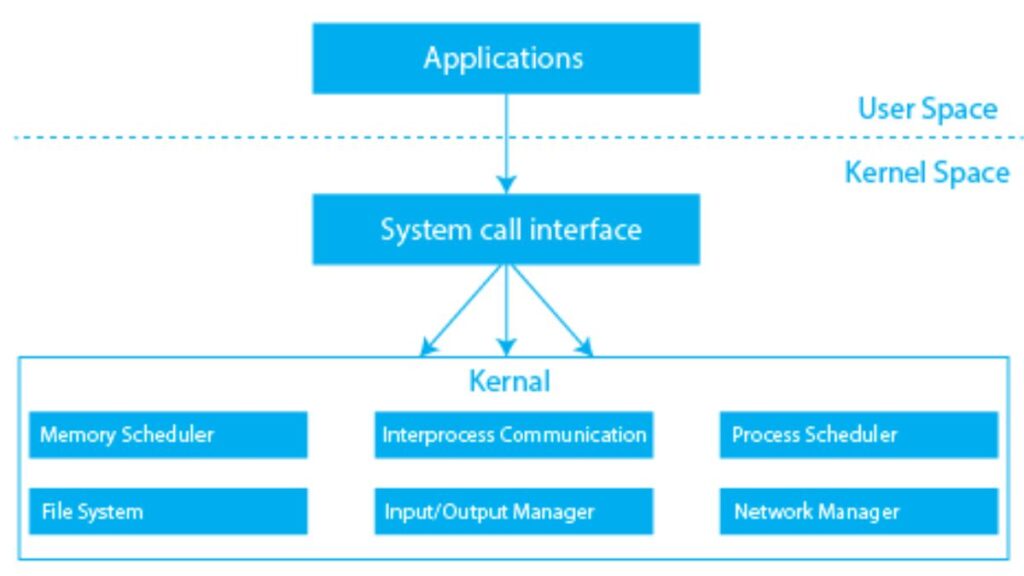Operating systems (OS) have undergone a radical evolution over the past few decades. From simple control programs in early mainframes to sophisticated, multi-layered software running on billions of devices today, the architecture of modern operating systems is a testament to the complexity and versatility required in contemporary computing. This article explores the architecture of modern operating systems, examining their fundamental components, how they interact, and what makes them critical to the functioning of our digital world.
The Role of Operating Systems in Computing
At the most fundamental level, an operating system is the intermediary between hardware and the user. It provides a consistent interface for application programs and users to interact with the computer’s hardware without needing to manage the intricacies of physical devices. Modern operating systems are designed to manage system resources such as the CPU, memory, disk space, and input/output devices efficiently and securely.
They also play a vital role in multitasking, process scheduling, device management, and user authentication. Whether you’re using a smartphone, a desktop, a server, or even an embedded system, an operating system governs the interaction between applications and the underlying hardware to ensure reliability, stability, and performance.
Core Components of Modern Operating System Architecture
To understand the architecture of modern operating systems, it’s helpful to break down the system into its key layers or components. Although implementations may vary slightly between systems like Windows, Linux, and macOS, the foundational architecture typically includes the following:
1. Kernel
The kernel is the heart of the operating system. It operates at the core level and has direct access to the hardware. The kernel is responsible for low-level tasks such as memory management, process scheduling, and hardware abstraction. There are several types of kernels used in modern operating systems:
- Monolithic Kernels (e.g., Linux): All OS services run in a single large process in kernel space.
- Microkernels (e.g., Minix, QNX): Only the most essential functions (like IPC and scheduling) are kept in kernel space; everything else runs in user space.
- Hybrid Kernels (e.g., Windows NT): Combines aspects of both monolithic and microkernel designs to balance performance and modularity.
2. Process and Thread Management
Modern operating systems are designed to be multitasking environments. This means they can execute multiple processes concurrently. The OS manages processes and their associated threads by allocating CPU time, handling process creation and termination, and ensuring isolation and communication between processes.
Thread management is equally important, especially in multi-core systems where different threads of a process can be executed in parallel. Efficient thread scheduling and synchronization are critical for performance and stability.
3. Memory Management
Memory is one of the most crucial resources managed by an operating system. Modern systems employ virtual memory to provide an abstraction of large, uniform memory spaces for processes, even when physical memory is limited. This includes:
- Paging and segmentation
- Swapping
- Memory protection
- Cache management
The OS uses these mechanisms to ensure each process has access to sufficient memory, prevents memory leaks, and maintains system performance.
4. File System Management
The file system is the component that manages how data is stored, retrieved, and organized on storage devices. Modern operating systems support complex file systems like NTFS, ext4, APFS, and others that include features such as:
- Journaling to prevent data loss
- Permissions and encryption for security
- Efficient file indexing and retrieval
- Mountable and network-based file systems
The file system acts as a structured, persistent interface between the volatile world of memory and the permanent storage on disk.
5. Device Drivers and Hardware Abstraction
Device drivers act as translators between the operating system and hardware devices. The OS includes a set of drivers that allow it to interact with various hardware such as keyboards, mice, printers, graphic cards, and network adapters without requiring the user to manage the hardware specifics.
This layer of abstraction makes it possible for software developers to write applications without worrying about the specifics of the hardware environment, enhancing portability and usability.
6. User Interface and Shells
While not every OS has a graphical user interface (GUI), most modern operating systems come equipped with either a GUI or a command-line interface (CLI) for interaction. The GUI typically includes windows, icons, menus, and pointer devices (WIMP), while the CLI provides direct control over the system via textual commands.
The user interface plays a crucial role in usability, allowing users to launch applications, manage files, and configure system settings effectively.
Modern Trends in OS Architecture
The architecture of modern operating systems is continuously evolving to accommodate new hardware capabilities, user demands, and security challenges. Some emerging trends include:
Virtualization and Cloud Computing
Operating systems are increasingly designed to support virtualization technologies, which allow multiple OS instances to run on a single physical machine using hypervisors. Cloud-based OS platforms rely heavily on this architecture to provide scalable and flexible computing resources.
Containerization
Unlike full virtualization, containerization (e.g., Docker, Kubernetes) leverages OS-level virtualization to run isolated applications with shared OS kernels. This is a lightweight alternative that is widely adopted in DevOps and cloud-native applications.
Security Enhancements
Modern OS architectures prioritize security, incorporating features like sandboxing, secure boot, biometric authentication, and real-time vulnerability patching. OS developers are also integrating hardware-based security models to protect against malware and kernel-level exploits.
Energy Efficiency
With the proliferation of mobile and IoT devices, modern operating systems are designed to be more energy-aware. They manage CPU states, control screen brightness, and optimize application behavior to extend battery life without sacrificing performance.
Comparative Look: Windows, Linux, and macOS
While the core architecture of modern operating systems is similar across platforms, each OS has its unique implementation and focus.
- Windows uses a hybrid kernel and offers deep integration with Microsoft services and enterprise environments. It emphasizes user-friendliness and wide hardware compatibility.
- Linux is open-source, using a monolithic kernel with modular capabilities. It’s highly customizable and is the OS of choice for servers, supercomputers, and developers.
- macOS is built on a Unix-based foundation with a hybrid kernel (XNU). It offers a polished GUI and deep integration with Apple hardware and software ecosystems.
Despite their differences, all three systems share architectural elements like memory management, process scheduling, and file systems, albeit implemented in unique ways.
The Future of Operating System Architecture
The future of operating system architecture will likely involve further abstraction, smarter automation, and tighter integration with AI and machine learning. Operating systems may become more context-aware, predictive, and adaptive, capable of dynamically adjusting to users’ needs in real time.
With edge computing, quantum computing, and advancements in neuromorphic hardware, future OS architectures will need to be even more robust, flexible, and intelligent to keep up with the demands of next-generation computing environments.
Conclusion
Understanding the architecture of modern operating systems is essential for anyone involved in computing, whether you’re a developer, system administrator, or just an interested tech enthusiast. These complex systems are the backbone of all digital operations, enabling users and machines to work seamlessly together. From the deep kernel-level processes to the user-friendly interfaces, every layer of an OS is meticulously designed to provide performance, security, and stability. As technology continues to evolve, so too will the architecture of operating systems—adapting to new challenges, embracing innovative paradigms, and continuing to power the digital age.



